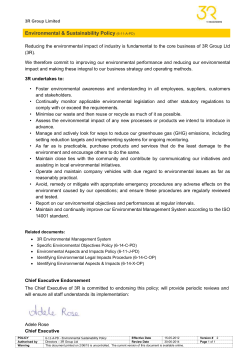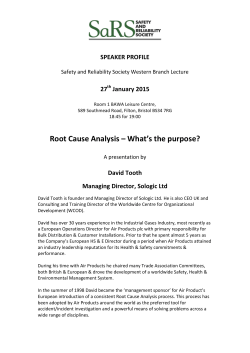
Coastal Processes and Landforms
Coastal Processes and Landforms These icons indicate that teacher’s notes or useful web addresses are available in the Notes Page. This icon indicates that the slide contains activities created in Flash. These activities are not editable. For more detailed instructions, see the Getting Started presentation. 1 of 43 © Boardworks Ltd 2005 Learning objectives How do waves operate? What are sub-aerial processes and why are they important? What processes of erosion operate at the coast? What landforms are created by erosion? What processes of transport operate at the coast? What landforms are created by deposition? 2 of 43 © Boardworks Ltd 2005 Why do waves break? Waves are the result of the wind blowing over the sea. As they approach land they break. The bottom of the wave touches the sand and slows down due to increased friction. The top of the wave becomes higher and steeper until it topples over. 3 of 43 © Boardworks Ltd 2005 Swash and backwash Backwash Swash Note: Backwash is always at right angles to the beach 4 of 43 © Boardworks Ltd 2005 Why are waves generally larger in the south west? Wave energy depends on the fetch, the strength of the wind and the length of time over which the wind has blown. fetch = the distance over which the wind has blown Look at an atlas or a wall map to find out the largest fetch around the British Isles. 5 of 43 © Boardworks Ltd 2005 Types of waves 6 of 43 © Boardworks Ltd 2005 What do you know about waves? 7 of 43 © Boardworks Ltd 2005 Learning objectives How do waves operate? What are sub-aerial processes and why are they important? What processes of erosion operate at the coast? What landforms are created by erosion? What processes of transport operate at the coast? What landforms are created by deposition? 8 of 43 © Boardworks Ltd 2005 What are sub-aerial processes? The coast is the narrow zone between the land and the sea. It is worth remembering that the landscape will be influenced by processes on the land as well as the sea. Sub-aerial processes include weathering and mass movement. These processes operate on the cliff face to weaken it and provide material for coastal erosion. 9 of 43 © Boardworks Ltd 2005 Impact of sub-aerial processes 10 of 43 © Boardworks Ltd 2005 Learning objectives How do waves operate? What are sub-aerial processes and why are they important? What processes of erosion operate at the coast? What landforms are created by erosion? What processes of transport operate at the coast? What landforms are created by deposition? 11 of 43 © Boardworks Ltd 2005 Processes of erosion 12 of 43 © Boardworks Ltd 2005 Processes of erosion Attrition Materials carried by the waves bump into each other and so are smoothed and broken down into smaller particles. Hydraulic action This process involves the force of water against the coast. The waves enter cracks (faults) in the coastline and compress the air within the crack. When the wave retreats, the air in the crack expands quickly, causing a minor explosion. This process is repeated continuously. Corrosion This is the chemical action of sea water. The acids in the salt water slowly dissolve rocks on the coast. Limestone and chalk are particularly prone to this process. Abrasion/Corrasion This is the process by which the coast is worn down by material carried by the waves. Waves throw these particles against the rock, sometimes at high velocity. 13 of 43 © Boardworks Ltd 2005 Do you know your coastal processes? 14 of 43 © Boardworks Ltd 2005 Learning objectives How do waves operate? What are sub-aerial processes and why are they important? What processes of erosion operate at the coast? What landforms are created by erosion? What processes of transport operate at the coast? What landforms are created by deposition? 15 of 43 © Boardworks Ltd 2005 Dorset coastline 16 of 43 © Boardworks Ltd 2005 Landforms of coastal erosion 1) Headlands and Bays 2) Cliffs and Wave Cut Platforms 3) Caves, Arches, Stacks and Stumps 17 of 43 © Boardworks Ltd 2005 Landforms created by erosion •Headlands and Bays They are most likely found in areas of alternating resistant and less resistant rocks. Initially, the less resistant rock is eroded away more quickly than the more resistant rock. The less resistant rock is eroded back to form bays. The more resistant rock is left protruding out to sea as headlands. 18 of 43 © Boardworks Ltd 2005 •Headlands and Bays Headlands are always exposed to wave attack. A bay is only eroded when waves with enough energy can reach the back. As a bay is eroded back, the waves must travel further over shallow sheltered water. There can be no more erosion until the headlands have worn back further. 19 of 43 © Boardworks Ltd 2005 Swanage Bay An example of headlands and bays on the Dorset coastline. 20 of 43 © Boardworks Ltd 2005 Headlands and bays 21 of 43 © Boardworks Ltd 2005 How are cliffs and wave-cut platforms formed? 22 of 43 © Boardworks Ltd 2005 Landforms created by erosion •Cliffs and wave-cut platforms Wave action is concentrated at the foot of a headland. Wave action is concentrated on weaknesses such as joints or fault lines. Hydraulic action and abrasion open up these weaknesses to form a groove or a wave cut notch. This starts to undercut the cliff. 23 of 43 © Boardworks Ltd 2005 •Cliffs and wave-cut platforms Continual undercutting of the cliff gradually increases the overhang. This sets up stresses and tension in the cliff until bits of rock fall into the sea or the cliff collapses As the cliff retreats, the eroded remains are gradually planed off by the sea, making a gentle sloping shelf or wave-cut platform. This wave cut platform is generally visible at low tide, covered with rock pools and seaweed. 24 of 43 © Boardworks Ltd 2005 Wave-cut platform The waves attack the base of the cliff through the processes of abrasion, corrosion, hydraulic action and attrition. Over time the cliff will be undercut and a wave-cut notch is formed. Eventually the cliff becomes unstable and collapses. Further cliff retreat will form a wave-cut platform. 25 of 43 © Boardworks Ltd 2005 Caves, arches, stacks and stumps Can you identify this famous Scottish Landmark? What do you think formed this feature?? 26 of 43 © Boardworks Ltd 2005 How are caves, arches, stacks and stumps formed? 27 of 43 © Boardworks Ltd 2005 Caves, arches, stacks and stumps 28 of 43 © Boardworks Ltd 2005 Caves, arches, stacks and stumps 29 of 43 © Boardworks Ltd 2005 The formation of caves, arches, stacks and stumps 30 of 43 © Boardworks Ltd 2005 Caves, arches, stacks and stumps 31 of 43 © Boardworks Ltd 2005 If these photos were taken of one headland over time, which of these landforms would be the first to be formed? 32 of 43 © Boardworks Ltd 2005 Learning objectives How do waves operate? What are sub-aerial processes and why are they important? What processes of erosion operate at the coast? What landforms are created by erosion? What processes of transport operate at the coast? What landforms are created by deposition? 33 of 43 © Boardworks Ltd 2005 How is sediment transported along the coast? 34 of 43 © Boardworks Ltd 2005 How is sediment transported along the coast? 35 of 43 © Boardworks Ltd 2005 Longshore drift Direction of movement Backwash is always at right angles to the beach swash Backwash This movement of sediment along the coastline is called longshore drift. 36 of 43 © Boardworks Ltd 2005 Longshore drift 1) Read the information of Page 100-101 (Geog.Scot 1) on Coastal Erosion and Transport. 2) In you jotters, draw a diagram to explain how Longshore drift moves stones and sand along a beach. 3) What influence does the Wave Direction have on the movement of particles? 37 of 43 © Boardworks Ltd 2005 Examination question Study the photograph of Swanage Beach. What is longshore drift? Add an arrow to the photo to show which direction longshore drift is operating in. Draw your own diagram to explain how longshore drift operates. 38 of 43 © Boardworks Ltd 2005 Learning objectives How do waves operate? What are sub-aerial processes and why are they important? What processes of erosion operate at the coast? What landforms are created by erosion? What processes of transport operate at the coast? What landforms are created by deposition? 39 of 43 © Boardworks Ltd 2005 Landforms of coastal deposition 1) Beaches 2) Spits 3) Tombolos and Bars 40 of 43 © Boardworks Ltd 2005 How are beaches formed? Beaches form in sheltered environments, such as bays. When the swash is stronger than the backwash, deposition occurs. Sometimes sand from offshore bars can be blown onto the shore by strong winds. In such cases dunes may form – such as at Studland on the Dorset Coast. 41 of 43 © Boardworks Ltd 2005 How are spits formed? 42 of 43 © Boardworks Ltd 2005 How are spits formed? 43 of 43 © Boardworks Ltd 2005 How are spits formed? 44 of 43 © Boardworks Ltd 2005 How are spits formed? 45 of 43 © Boardworks Ltd 2005 Pagham, West Sussex Sketch and annotate this aerial photograph using the words below. 46 of 43 © Boardworks Ltd 2005 What is a tombolo? If a spit joins the mainland to an island it is called a tombolo. At Chesil Beach in Dorset, the mainland is joined to the Isle of Portland. 47 of 43 © Boardworks Ltd 2005 48 of 43 © Boardworks Ltd 2005 Chesil Beach Study the photograph. Y X Portland From what direction was the photograph taken? Name features X and Y. 49 of 43 © Boardworks Ltd 2005 What is a bar? If a spit joins one part of the mainland to another it is called a bar. For example, there is a bar at Orford Ness in Suffolk. 50 of 43 © Boardworks Ltd 2005 Coastal landforms in Studland 51 of 43 © Boardworks Ltd 2005 Erosion or deposition? 52 of 43 © Boardworks Ltd 2005 How much do you know about coasts? 53 of 43 © Boardworks Ltd 2005 Key Ideas Waves are the result of the wind blowing over the sea. They break as they approach land. Swash and backwash describe the movement of a wave on the beach. Fetch is the distance that the wind has travelled. Sub-aerial processes such as weathering and mass movement occur on the cliff face. Coastal processes of erosion include hydraulic action, attrition, corrosion and solution. Landforms created by erosion include headlands and bays, caves, arches, stacks and stumps. Longshore drift is a method of coastal transport. Landforms created by deposition include beaches, spits, tombolos and bars. 54 of 43 © Boardworks Ltd 2005 Key Ideas Waves are the result of the wind blowing over the sea. They break as they approach land. Swash and backwash describe the movement of a wave on the beach. Fetch is the distance that the wind has travelled. Sub-aerial processes such as weathering and mass movement occur on the cliff face. Coastal processes of erosion include hydraulic action, attrition, corrosion and solution. Landforms created by erosion include headlands and bays, caves, arches, stacks and stumps. Longshore drift is a method of coastal transport. Landforms created by deposition include beaches, spits, tombolos and bars. 55 of 43 © Boardworks Ltd 2005 56 of 43 © Boardworks Ltd 2005
© Copyright 2025









